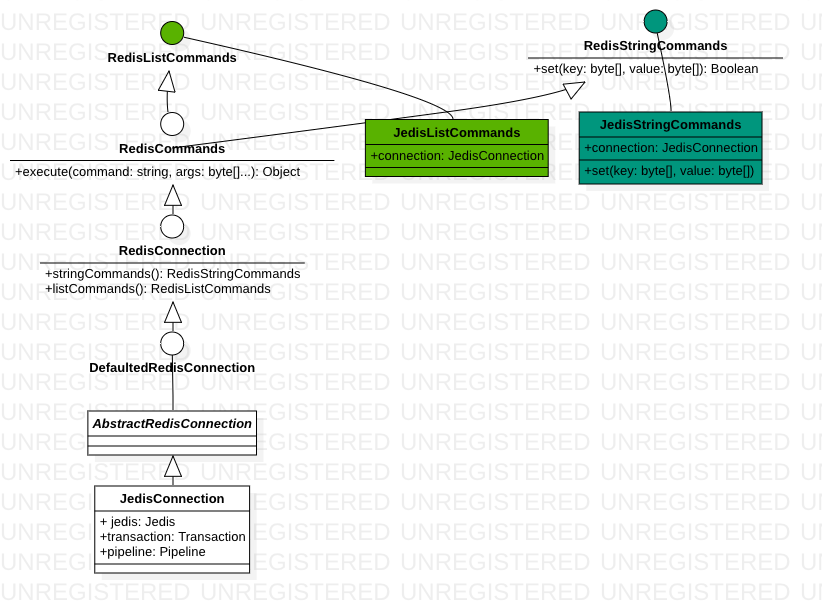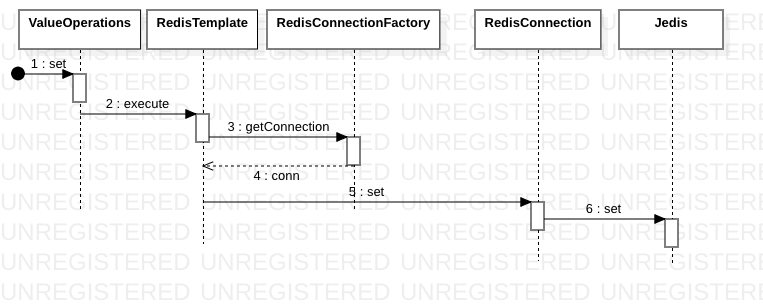spring redis 源码分析
简介
Spring Data Redis 源代码 spring-projects/spring-data-redis 示例代码
ListOperations<String, Person> listOps = template.listOps();
listOps.rightPush(random, new Person("Jane", "Smith"));
List<Person> peopleOnSecondFloor = listOps.range("users:floor:2", 0, -1);
背景Jedis源码分析
spring-data-redis实现
下文仅以redis 五种类型的 String和List 数据结构为例:

RedisTemplate 和ValueOperations、ListOperation 互相持有对方的引用, RedisTemplate 作为用户操作的入口对象, ValueOperations、ListOperation 等负责分担五种数据类型的 操作。

- 数据操作最终由 JedisConnection 来完成
- 从spring-data-redis 实现看,spring-data-redis 只是将jedis 作为 redis 访问的工具之一,并没有严格绑定
- JedisConnection 与 JedisStringCommands、JedisListCommands 等互相持有对方的引用,JedisStringCommands、JedisListCommands 等负责分担五种数据类型的 操作。

public <T> T execute(RedisCallback<T> action, boolean exposeConnection, boolean pipeline) {
RedisConnectionFactory factory = getRequiredConnectionFactory();
RedisConnection conn = null;
try {
if (enableTransactionSupport) {
conn = RedisConnectionUtils.bindConnection(factory, enableTransactionSupport);
} else {
conn = RedisConnectionUtils.getConnection(factory);
}
boolean existingConnection = TransactionSynchronizationManager.hasResource(factory);
RedisConnection connToUse = preProcessConnection(conn, existingConnection);
boolean pipelineStatus = connToUse.isPipelined();
if (pipeline && !pipelineStatus) {
connToUse.openPipeline();
}
RedisConnection connToExpose = (exposeConnection ? connToUse : createRedisConnectionProxy(connToUse));
T result = action.doInRedis(connToExpose);
if (pipeline && !pipelineStatus) {
connToUse.closePipeline();
}
return postProcessResult(result, connToUse, existingConnection);
} finally {
RedisConnectionUtils.releaseConnection(conn, factory);
}
}
RedisTemplate使用模板模式,提供了高层调用结构和基本的逻辑实现(execute逻辑就是:建连接,序列化,发请求数据,拿数据,返回)。ValueOperations、ListOperation 对应的命令由它们自己实现,双方的结合点就是callback。这和spring-jdbc中的JdbcTemplate非常相像。
ScriptingCommands
redis中提供对lua脚本的支持,jedis和sdr自然也不甘落后,也都提供了支持。
反应在jedis上,就是ScriptingCommands接口,从中可以看出一种感觉,eval命令和set命令并无本质不同,在实现上都是完成参数的传递即可,并没有因为其功能不同,有特别的处理。
public interface ScriptingCommands {
// 以eval方式执行lua脚本
Object eval(String script, int keyCount, String... params);
Object eval(String script, List<String> keys, List<String> args);
Object eval(String script);
// 以evalsha方式执行lua脚本
Object evalsha(String sha1);
Object evalsha(String sha1, List<String> keys, List<String> args);
Object evalsha(String sha1, int keyCount, String... params);
// 判断lua脚本是否存在
Boolean scriptExists(String sha1);
List<Boolean> scriptExists(String... sha1);
// 加载lua脚本
String scriptLoad(String script);
}
正文到此结束
热门推荐
相关文章
Loading...











![[HBLOG]公众号](http://www.liuhaihua.cn/img/qrcode_gzh.jpg)

